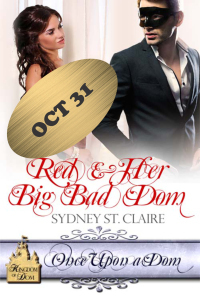Andrea Downing's Blog, page 13
January 3, 2015
The Girls Who Civilized the Old West
[image error] B J (Bill) Scott is a novelist who sets his stories in the mid to late 19th century of the American West. He is the author of five books: The Angel Trilogy, Light On A Distant Hill, and the newly-released The Rail Queen. His fourth novel, Light On A Distant Hill: A Novel of the Indian West, won the 2011 WILLA Literary Award, sponsored by Women Writing the West, for Best Original Softcover Fiction. All his books feature stories built around strong, ambitious women: determined, relentless, sometimes hot-tempered, and fearless. Locales range from the California Gold Rush to San Francisco, Hong Kong, Idaho, Montana, and Kansas.
Bill holds Bachelor’s degrees from Washington State University and Brooks Institute of Photography. He is a former professional photographer, civil servant, and college instructor of public speaking. He lives in Oregon with his wife and youngest son.
The Rail Queen, the fifth book of my “Tales of Strong Women” series, begins in 1884 Missoula Montana, where 17-year old Ryka Sundstrom nurtures a passion for steam locomotives, and secretly dreams of having her own railroad someday. Discouraged at every turn and violently opposed by her traditionalist Old World Swedish father, Ryka is driven from her home into the Midwest, where she fights for her vision against enormous odds. Although this novel is not about Harvey Girls or Harvey House Restaurants, my heroine does spend some time in that environment as she struggles to survive to pursue her dream. I thought it might be worthwhile to take a brief look at one of the most famous institutions of the late 1800s in the American Midwest.
First, one must understand what prompted Fred Harvey to begin his venture. Meal stops on Midwestern trains in the 19th century were the stuff of nightmares. When a train pulled into a depot, there was a mad scramble for the counter of the depot diner, as time and space was extremely limited. No matter whether it was breakfast, lunch, or dinner, the fare was unfailingly the same: fried steak, eggs, and fried potatoes. Some passengers fortified themselves beforehand with a dose of bourbon or whatever whiskey was available, in hope of being able to better stomach the fare. It didn’t always work, as it was not unusual to see passengers vomit their meal along the tracks before re-boarding. Even so, space at the counter was so prized that fistfights sometimes broke out. The all-aboard whistle sounded so quickly that many did not finish their meal. What was left on the plate was sometimes saved and served again to the next train’s passengers.
Out of this chaos were born the Harvey House restaurants. Turned down by the Burlington Railroad Company, Fred Harvey turned to the Santa Fe, which accepted his proposal to provide service equal to the finest hotel dining Harvey had experienced in New York. Harvey House Restaurants were the wonder of their time, serving top-notch fare on fine linen on a table set with crystal and fine china. No gentlemen were seated without jackets, which were provided if necessary. The first Harvey House opened in Topeka, Kansas in 1876.
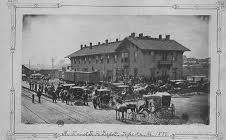
The Topeka Depot of the Atchison, Topeka, and Santa Fe circa 1880. The Harvey House Restaurant was on the second floor. Photo courtesy of Kansas Historical Society
One of the mysteries to diners was that after they were seated and drink requests were taken, a second Harvey Girl soon arrived and without a word promptly placed the proper drinks in front of each customer. How could she know? What the diners hadn’t noticed was that the waitress who seated them and took their drink orders had coded the table: a cup right side up in the saucer meant coffee; upside down, hot tea; upside down and tilted against the saucer, iced tea; upside down and off the saucer, milk.
In the early 1880s there were seventeen Harvey House restaurants along Santa Fe’s main line. To staff them, Harvey advertised far and wide for young women of good character and morals. Here is his actual newspaper recruiting advertisement.
“Young women, 18 to 30 years of age, of good moral character, attractive and intelligent, as waitresses in Harvey Eating Houses on the Santa Fe Railroad in the West. Wages $17.50 per month with room and board. Liberal tips customary. Experience not necessary. Write Fred Harvey, Union Depot, Kansas City Missouri.”
For girls of the day, it was a superb opportunity, offering good wages and benefits in contracts of twelve, nine, or six months. Girls selected at sites such as New York received free first-class rail transportation to their training facility. And throughout their employment, they received free rail transportation on all Santa Fe lines.
Training was rigorous, and appearance standards were high. All Harvey Girls wore black and white outfits consisting of a black ankle-length dress and a white apron over a black blouse. There were slight variations to this scheme at different locations. Shoes were also provided.
The girls lived in dormitories that were off-limits to the public, overseen by a strict housemother. They were allowed out to dances and such, but had to be back in the house before curfew (ten o’clock on weekdays; twelve o’clock on weekends). Woe unto those who were not. Men were not allowed in dormitories, but there was a small courting room off the front parlor where gentlemen callers could converse with the girls for a limited period.
On the job, standards and expectations were high. There was a detailed routine regarding table setting, and it had to be perfect. All Harvey Girls lived with the daunting possibility of a surprise visit from Harvey himself. Though he took care of his girls generously, he was known to become angry when he discovered flaws. On one occasion he found a table set incorrectly, and abruptly grasped the tablecloth and pulled the entire setting to the floor.
The fare was superb, and portions were generous. Steaks were cut thick; pies were cut into quarters rather than eighths. Seconds were encouraged. Periodically a waiter would emerge from the kitchen with a tray piled high with steaming cuts of steak. Waitresses would take meat from the tray directly to their waiting customers. Orange juice was to be freshly squeezed for each customer, and pity the manager whom Harvey discovered with a pitcher of juice in the cooler. No item was to be taken to the table unless it was delivered on a tray. Girls were not to engage the customers in conversation beyond that required to serve them. A detailed description of Harvey Girl training and work practices is contained in The Rail Queen. Despite these strict standards, Harvey Houses were generous to the needy, and refused no one a meal.
It is estimated that more than 100,000 Harvey Girls worked for Harvey House restaurants. And there was the added bonus of exposure to potential husbands. The job provided the girls with pride and independence; any man who was attracted to them soon found they were a different breed than the saloon girls he might be familiar with. Will Rogers once said Harvey and his young servers “kept the West in food and wives”. A railroad baron of the day stated, “The Harvey House was not only a good place to eat; it was the Cupid of the rails.” Though Harvey Girls were severely discouraged from marrying during their contracts, it is thought that over 20,000 Harvey Girls married one of their regular customers.
When Fred Harvey died in 1901, there were 45 restaurants and 20 dining cars in twelve states. His sons continued the business, and Harvey House restaurants continued to be built into the 1930s. At its peak, there were 84 facilities. But over the opening decades of the twentieth century, Harvey Houses faded away. A decline in railroad traffic and the development of automobile and air transportation had much to do with it. Tragically, most of the Harvey House restaurants were torn down along with the rail depots that housed them. The last Harvey House constructed was built next to Los Angeles’ Union Station in 1939. It closed as a restaurant in 1967. Thankfully, it is perfectly preserved and sometimes available for tours through the L. A. Conservancy.
For those interested in further information on Harvey Girls and Harvey House restaurants, I recommend looking online at the Kansas Historical Society, the Oklahoma Historical Society; at http://www.oerm.org/harvey-girl-historical-society, and the City of Florence, Kansas website. My favorite site is “A Harvey House Home Page” at http://www.harveyhouses.net/. This contains photographs and information on the fate of virtually all of the Houses.
***********************************************************************
Bill has kindly offered to give one copy of The Rail Queen to the person who leaves the most interesting comment. The winner is Alice Trego. Thanks to everyone who stopped by.
The Rail Queen is available in paperback at the author’s website: bjscotthistoricals.wordpress.com, which contains excerpts from all five books.
It is available in paperback and ebook at createspace.com/5028104, and amazon.com, including ebook for kindle.
Paperback copies are also available from the author: write scotts2294@att.net
[image error]It was a time of vanishing cultures and rising empires. A time when there was much that needed to be done—much that could be done. And in the end it didn’t matter who did it.
Seventeen-year old schoolgirl Ryka Sundstrom dreams of doing what no girl ever has—build a railroad. Fleeing her home and an arranged marriage, pursued across four states by a vengeful father bound by tradition, Ryka unites with a childhood sweetheart in Kansas, only to suffer his later betrayal. Surrounded by people who tell her girls don’t build railroads, Ryka refuses to give up. When near defeat In the face of overwhelming odds, she offers herself to a potential backer. Will her new partner in business be her partner in love as well, or will he too turn against her? The truth will be told when ambition and boldness lead Ryka to a showdown with the feared Empire Builder of the Great Northern Railway—James J. Hill.

December 11, 2014
A Brief Reflection on the Holidays
 Recently, I’ve had a few health issues, which are making me sit down and take stock and think about things to be thankful for—and there really is plenty at this time of year. I love the tree lighting, the scent of pine as I walk city streets past tree sellers, the buoyant mood of people rushing against chill air to join loved ones. I love the food, the games, the being together and the age-old decorations. I’m happy to see Santas on street corners collecting for charity and uniformed Salvation Army members ringing their bells. Displays in shop windows are a fascination, and the extra street lighting makes everything look so much more cheerful.
Recently, I’ve had a few health issues, which are making me sit down and take stock and think about things to be thankful for—and there really is plenty at this time of year. I love the tree lighting, the scent of pine as I walk city streets past tree sellers, the buoyant mood of people rushing against chill air to join loved ones. I love the food, the games, the being together and the age-old decorations. I’m happy to see Santas on street corners collecting for charity and uniformed Salvation Army members ringing their bells. Displays in shop windows are a fascination, and the extra street lighting makes everything look so much more cheerful.
The holiday season now also unfortunately entails non-stop shopping, continuous ads on television for every sale going and blatant commercialism. Maybe it’s human nature to want the bargains, to hunt the deals, and Life has become so inundated with things, with stuff, any way to get it all at the best price is welcome. So many times I’ve been asked why I write western historical stories and what the appeal is. To me—and I know this is very personal—there is something far more appealing about that life. Their Christmas would have had simple decorations, homemade gifts, a joy in just being together rather than the mad rush to buy, buy, buy. SURELY it was more fun to pop corn and string it up with sour apples than to go out and buy colored balls, tinsel and various other little ornaments to hang on the tree—made in China? Surely, the hand-knit sweater meant more to the receiver than the latest iPad or phone?
Maybe not. Humanity hasn’t really changed; these items were simply not available so folks were happy with what they got. But happiness is still, pretty much, based on the same agenda. We’re happy to have our health, our home, our family and friends who support us.  We still gasp at a breath-taking dawn and the beauty of a sunset behind majestic hills. We’re in awe at the variety of wildlife in a setting that stuns us into silence, while the laughter of loved ones and children and those close to us still tugs at our hearts.
We still gasp at a breath-taking dawn and the beauty of a sunset behind majestic hills. We’re in awe at the variety of wildlife in a setting that stuns us into silence, while the laughter of loved ones and children and those close to us still tugs at our hearts.
At least that’s what I’m thankful for. What are you thankful for and what are you looking forward to in the New Year? Please let me know… I have 3 simple gifts to give away, and a cartload of good cheer.
There are 2 digital copies of my books to give away and 1 surprise gift. The winners are Irene Bennett Brown, Mary M. and Vicki Batman. Thanks to everyone who responded!
BEST WISHES FOR A VERY MERRY CHRISTMAS AND A HAPPY AND HEALTHY NEW YEAR!!

November 6, 2014
Mormon Row: Historic Site or Ghost Town?
What is the difference between a ghost town and a vacated historic site? Is there one?
Recently, back up in the Tetons, I ventured with a couple of friends to visit
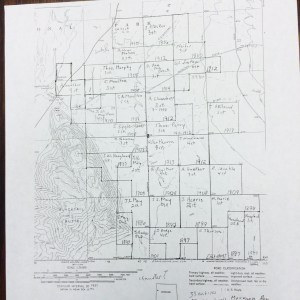
Map of Mormon Row drawn by Craig Moulton, courtesy of Jackson Hole Historical Society and Museum
Mormon Row, a four mile stretch of homesteads and ranch houses just southeast of Black Tail Butte in the valley of Jackson Hole. Here were solid, but decaying, remnants of a community that once thrived, was vibrant with life, if not exactly prosperous by today’s way of understanding. The National Park leaves its historic buildings to decay naturally, which I daresay means that, with time, they’ll be gone. But for now, the buildings stand as a monument to what people do to secure a better life, to survive, perhaps also a monument to what really matters in life.
The first homesteaders came from Rockland, Idaho, stopping in Victor before
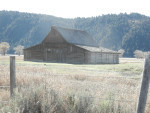
Thomas Alma & Lucille Moulton Homestead, ca.1910
crossing the Teton Pass. Nowadays, we have a road, which, I have to say, I’m somewhat reluctant to drive, yet they crossed the pass in wagons. They camped in Wilson, where I now abide part-year, on Fish Creek, before moving on to make their claim for 160 acres under the Homestead Act, paying their $21 claim fee. Some would secure further acres under the Desert Land Act, which required them to irrigate the land.
Arriving in July, too late to plow or plant, water and shelter were their first concerns. They dug irrigation ditches, and dug down 120ft. or so for wells. To be sure water would be available in summer, this was the time to dig—when water would be at its lowest. Then they built log cabins with a dirt roof, the lodge pole pines coming from nearby forests. And they went to Flat Creek, where hay was available for anyone who wanted it, cut it by hand, and also planted an early maturing oat, ready in 90 days. Plowing through the sage brush, with either a hand plow or a sulky plow, the soil underneath was fertile, and the resultant burning sage made an evening’s entertainment.
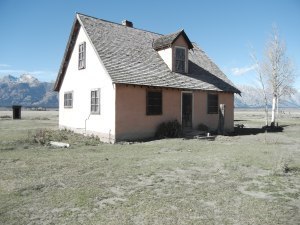
John & Bartha Moulton Homestead, ca. 1910
The community was called Grovont. Mostly ranchers, the cattle raised were not for their own consumption. Their subsistence depended on elk meat, hung in winter and left to freeze until they wanted it, and hogs killed and cured in summer, then wrapped in newspapers to keep the flies away. Huckleberries were another staple along with garden vegetables they could grow in the short season: rutabagas and carrots predominated. The cattle they owned were to raise money for other necessities; the steers were driven to Victor, Idaho, to put on the train for Omaha and sales. But since the price of a steer could vary as much as between $29 and $600, income was not guaranteed. Some families traded hay, eggs or chickens, oats or cream for butter down in the town of Jackson. The Moultons, of Moulton barn fame (the most photographed barn in the country, apparently) had a dairy
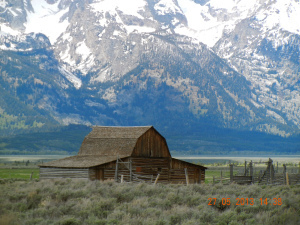
Moulton Barn
and sold milk to the local dude ranches. In addition, there was trapping, and one could earn about $50 a month from coyotes.
So, was there any recreation in this subsistence-level existence? Of course! The Church was a major center of activity, not only for services but especially for dances. Everyone danced, and dances were twice a month at the church (but no drinking or smoking allowed). Still, they lasted until 3 a.m., and there’s a story about the piano player having to tape his bleeding fingers. Christmas and Halloween parties were well attended, political rallies, weddings and harvest celebrations, and concerts and school plays, too. Even in winter, when temperatures could drop to -60, and -27 or so was a norm, irrigation ditches became ice skating rinks, and the butte afforded skiing and sledding, while in summer there was swimming in nearby water holes.
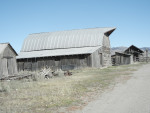
Andrew & Ida Chambers Homestead, ca. 1920
In 1925, the Gros Ventre mud slide on Sheep Mountain damned the Gros Ventre River east of nearby Kelly, Wyoming, and caused a lake to be formed. Two years later, the damn failed, flooding Kelly and killing six people, yet uncovering a warm spring that never freezes. The Mormons called it ‘The Miracle Spring’, and they dug ditches to bring the water that would never freeze to their homesteads year-round. So life went on, improved somewhat. Better houses were ordered from the Sears Roebuck Catalogue and shipped by rail to Victor, then brought by stage over the Teton Pass and erected by community effort. Other new houses were stucco with cement. Out-buildings were built: log barns, granaries, and pump houses. School, originally in someone’s living room before moving to the Church basement, finally had its own building when someone donated land. Mail came in by team or sleigh from Jackson or Moran. Kerosene and gas light gave way to electricity in the 1950s.

Thomas Perry Homestead, ca. 1910
So, what happened to this vibrant community? Admittedly, it was at subsistence level, but the homesteaders had made a conscious choice of the life they wanted, and this was it. But in the 1950s, the government started a buy-out of the land that was unproductive. The Snake River Company, with Rockefeller money behind it, bought up marginal lands, and then moved in on the homesteaders whose older generation took the money, with life leases permitting them to stay their lifetimes. John Moulton was the last to close at his death in 1990. And so, this community became part of Grand Teton National Park.
So now, is it a ghost town or an historic site? What is the difference? Perhaps it is that a Ghost Town is abandoned, a place where subsistence is no longer viable. Mormon Row, the former community of Grosvont, could have continued, but Time and Progress overtook it. The people saw the sense of taking the money and running with it, of leaving the area for future generations that would appreciate the enlarged Grand Teton National Park. Yet, the ghosts are still there. It’s an historic site, yes, but one that resonates with its history, as well as lost possibilities, forgotten potential.
Today, the Church, which served as such a center of community life, serves as the Calico Pizza, my local restaurant in Wilson, Wyoming. I eat there yet see no ghosts, nor even history.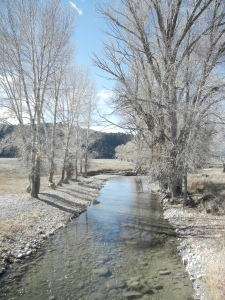
***********************************************************************
My sincere thanks to Emily Winters, Director of Archives at the Jackson Hole Historical Society and Museum, for her assistance in my research for this article.

October 23, 2014
The Good, The Bad, & the Ugly of Deadlines: Pt. 2
Sydney St. Clair continues:
Today, I’ll finish talking about deadlines, those necessary evil’s of life. Let’s look at:
Types of Deadlines Writers Face
Completed Manuscripts This is the most common and the most important. None of the other deadlines can happen until you meet this one, and no one else will be able to meet their deadlines unless you meet yours. If you are not published yet, you will never be published unless you finish that manuscript or two or three. As said earlier, being productive and making progress is the key to making writing a career.
If you don’t set yourself a deadline, you might spend years working on the same story without working forward. Now this is not necessarily totally bad. You do have to learn the craft, whether it’s on one book or four.
I spent seven years on the first book, with some starts on other works, and one other complete manuscript written during that time. . But that book one wouldn’t let go so I learned my craft on it and was determined to see it sold. For me, it worked but it’s rare in this business to sell your first manuscript.
Proposals
White working on your manuscript, many authors send out proposals to agents/editors. The process of waiting is so long, it makes business sense to see if anyone is interested. But before you send those proposals out, know how long you need to finish if your ms is requested. Agents and editors are not going to wait a year for that ms. They want it now. More than month is too long so again, learn how fast you write and plan accordingly around your deadline.
Writing Goals
All serious writers who want to be published and successful should treat your writing as a business. And this means goals. You need your deadline goals:
Daily/Weekly: word/pages, social media, website, etc. What do you need to achieve short term for those long-term goals/deadlines?
Yearly Goals: How many books completed, sent out, in various stages of writing, revising, editing etc. Daily/weekly help meet these deadlines/goals
Five Year Goal: Where do you want to be in five years? It’s true that there’s much you cannot control in this business but you can control your production and progress with deadlines and goals. If you want four complete manuscripts, then you need those deadlines and you need them broken down so you can see how to achieve that goal.
Promotion Deadlines
This is an on-going task. First, know your publishers process. How long from the time you turn in your ms to its release day? Typically, it’s 7-12 months. Smaller houses and e-pubs are much shorter. Currently, I have about 8 weeks! And if you are writing a series, you will be in process of promoting the book you just turned in, the one coming out, and the ones already out. Add the one you are just about to start and that’s even more. Some deadlines area:
Soliciting for reviews
Setting up blog tours
Setting up book signings (if print and if there are bookstores in your area)
Coming up with promo material and knowing lead times to get said material in time.
Press releases
Social media
Launch parties and probably a lot more depending on how much you decide to do
10 Facts of Deadlines
Fact 1: Deadlines are a necessary evil. They are a part of the writing business. If you want to succeed, you have a long list of deadlines in your future. Aside from the deadline of turning in your book, there are revisions, edits, copy edits, galleys, book fact sheets, and more. Then there are all the marketing deadlines, promotional deadlines, and enough other deadlines to scare off those who are faint of heart. This is not a business for those who fear those pesky deadlines.
Fact 2: Deadlines are Hell. Life doesn’t stop or slow down just because you have a deadline. I know. I’ve had tough deadlines, and there were times I couldn’t make them. I’ve written through death in the family, health problems, and family problems. Children, spouses, pets, changes in your life like moving, all rear their ugly heads at the worst possible time.
Yes, you can ask for extensions but if you do this too often or don’t meet those extended deadlines, you lose credibility. And keep in mind, those life issues will continue to crop up over and over, and you the writer have to learn to write in spite of whatever life tosses your way. Picture a little gremlin lurking in the corner just waiting to thwart you and turn your well-ordered life into chaos.
Fact 3: Good, Bad &Ugly, Deadlines Change the Way You Write. As I mention in the first part of this article, deadlines change the way you write. There is so much of the writing life that eats our writing time. The very act of selling, negotiating, announcing, enjoying that heady “sale” moment can easily eat up a month. Or two. Then there is all that time on email, research, learning the craft of this business, marketing, and promotion and yes, googling our name and book titles for reviews. When is there time to write?
Well, it doesn’t get better after you’ve sold your first book, or your tenth. Now is the time to learn self-discipline. Depending on what you write and where you sell, you may be asked to provide your next book in as little as six months. Or if you are me, with a new six book series of novella length stories, six-eight weeks! And let’s say you have six months to turn in your next book. You may lose a good two months due to life. Setting a deadline, knowing where you are on your book at all times, will help keep you on track.
With my novella’s, I know how many days and hours each book takes. I plan out a certain word count per day and yes, there are days that I have to double that to make my deadline. But knowing how much time I need is invaluable to setting and making my deadlines.
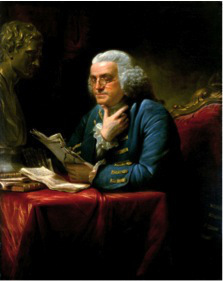 Fact 4: Deadlines Are A Way Of Life. Meeting deadlines is a sign that you are a professional, something your editor and publisher both want and expect. Yes, writing is an art but once you sell, you merge the art with business and it’s the business that will make or break you. Your publisher needs and wants reliable wordsmiths, not temperamental artists. Before selling, writers can write as the muse hits, when they have free time, when the kids are behaving and the spouse is in a generous mood etc. Once we are on deadline, we have to deal.
Fact 4: Deadlines Are A Way Of Life. Meeting deadlines is a sign that you are a professional, something your editor and publisher both want and expect. Yes, writing is an art but once you sell, you merge the art with business and it’s the business that will make or break you. Your publisher needs and wants reliable wordsmiths, not temperamental artists. Before selling, writers can write as the muse hits, when they have free time, when the kids are behaving and the spouse is in a generous mood etc. Once we are on deadline, we have to deal.
We free-spirited artists can go weeks without writing and justify it as “family comes first,” or taking a break, or whatever. We can rewrite and rewrite and rewrite and perfect those first three chapters to our hearts content. We can agonize over every little scene. We can create elaborate character sheets, charts and other “busy” work to show we are writing. We can look good; we can look professional with all those trappings and feel great.
But the ugly truth is, much of that isn’t writing—it’s the pretense of writing. It’s not putting words down onto paper and pushing toward a deadline. When you have six months or a year or whatever to write a book, and you know that life will nibble away at some of that time, you don’t have a lot of time for fancy. That nasty deadline looms and reality doesn’t care if you have pretty charts.
Fact 5: Deadlines Change The Way You View Writing. Okay this is a big one folks. When you have deadlines, writing is no longer something fun you do because you want to do it. Now you have to write. Now it’s work. Now it’s a job. Suddenly, that story you came up with, provided a ten-page synopsis on, wrote those first 30-50 pages, were so eager to sell, doesn’t seem very interesting, isn’t working, the characters aren’t coming to life, etc. In fact, you even hate those characters and that stupid plot—why did I want to write this story in the first place?
What you thought would happen isn’t. And you’re stuck having to write that damn story because you sold the story and you are under deadline. You have to make it work. Somehow…
Fact 6: Deadlines Force You To keep Writing. Even if you think it’s all bad, even if you don’t know what you’re doing, even when you just want to toss in the damn towel. That sneaky, pesky deadline keeps you writing. There’s nothing like pressure to make you vomit those words onto paper.
Fact 7: Deadlines Motivate You. They hold you accountable. You can’t put off writing. The clock is ticking. No time for hand wringing, dilly-dallying around or overthinking your writing process. You have that invisible teacher/boss standing there, tapping his /her foot, or holding your paycheck hostage. I am a procrastinator. Deadlines keep me from giving in and putting off what needs to be done now. Deadlines make me get organized and busy.
Fact 8: Deadlines Include Synopsis. Unfortunately, in order to get that sale which means a coveted deadline (yeah, you want that deadline because that means you are succeeding in your writing career) you have to write that synopsis.
Fact 9: Synopsis Are A Necessary Evil. Just as deadlines are a necessary evil. No one said writing was all fun and games.
Fact 10: Synopsis suck. Deadlines suck. Get over it, get used to it, and embrace it. Your writing career will thank you.
When it comes to deadlines, there is a lot to consider and a lot of benefit. So, do you set deadlines? Why or why not? Do you meet them? What tricks or advice do you have to share to help others set and meet their deadlines?

October 14, 2014
The Good, The Bad, & the Ugly of Deadlines
For the next couple of weeks, I have fellow author from The Wild Rose Press,  Sydney St. Clair visiting and talking about that dreaded part of author’s lives: deadlines!
Sydney St. Clair visiting and talking about that dreaded part of author’s lives: deadlines!
Sydney St. Claire is the pseudonym of Susan Edwards, author of 14 Historical Native American/Western/Paranormal romances and the author of the popular “White” Series.
Sydney loves writing and sharing stories of love, happiness and dreams come true with her readers. She credits her mother for her writing success. Encouraged to read as a child, she always preferred happy endings which meant romances were her favorite genre. Sydney takes her readers into the world of erotica romance where her characters come together in explosive passion as they solve life’s problems and find true love along with the best sex our hero and heroine have ever experienced.
Sydney’s office is quite crowded with three dogs at her feet and five cats to keep her company while she writes. Three cats always insist on beds on her desk, barely leaving enough room for her monitor and keyboard. Life gets fun when all five insist on supervising…
When not writing, she enjoys crafts of all sorts including quilting, sewing, cross-stitch and knitting. She and her husband of 30 + years are avid gardeners. He takes care of the veggies, and Susan is in charge of the ‘pretties’. Her medicine wheel garden is in a contact state of war: flowers vs. weeds. Sadly, right now the weeds are wining…
While writing, she listens to a wide variety of music. Her current favorites are Blackmore’s Night and David Lanz.
The Good, The Bad, & the Ugly of Deadlines
By Susan Edwards, writing as Susan Edwards & Sydney St. Claire
Definition of Deadline: the latest time for finishing something as copy for a publication. A line or limit that must not be passed.
Deadlines have been part of my life for more years than I care to count. As much as writers hate them, they are also our friends. I’ve had some downtime in my career when my publisher went out of business and when life took some unexpected turns, and I speak from experience when I say that having a deadline makes a writer, at least this writer much more productive.
No deadline means I meander and play around. No deadline means there’s no one holding me accountable. No deadline means no writing income. Or no new writing income.
The 5 P’s of Why You Should Set Deadlines
Publishers
 If you are writing with the intent to sell, you’ll eventually have to meet deadlines so you might as well get used to it now. Spend the time now to learn the ins and outs of writing on deadline. How do you handle the pressure—self-imposed and how does it affect your writing? The time to find out is before you find yourself on deadline! What you know now about yourself won’t surprise you or send you into a panic later. If you absolutely cannot write a book in less than a year, then you certainly don’t want to agree to a six-month contract. The only way to know is to keep track now and learn what you can and cannot do.
If you are writing with the intent to sell, you’ll eventually have to meet deadlines so you might as well get used to it now. Spend the time now to learn the ins and outs of writing on deadline. How do you handle the pressure—self-imposed and how does it affect your writing? The time to find out is before you find yourself on deadline! What you know now about yourself won’t surprise you or send you into a panic later. If you absolutely cannot write a book in less than a year, then you certainly don’t want to agree to a six-month contract. The only way to know is to keep track now and learn what you can and cannot do.
One thing I learned once I was contracted, and facing deadlines was that I could not continue to be a leisurely writer. I couldn’t keep polishing as I went. I was forced to forge ahead and ignore some issues, though I’m the type of writer that if there is something wrong, it’s difficult for me to move forward. The discovery of Power Writing has help immensely. I can be fast and productive as well as efficient.
Being on deadline also meant I couldn’t spend lots of time perfecting character sheets, fancy plot charts etc. which was something I did and told myself it all had to be perfect but in reality, it was an excuse not to write and move forward.
Now, I allow myself a certain amount of time to plan and plot. Once I start writing, the deadline clock starts ticking and there’s no luxury of playing around and procrastinating. These days, with one deadline following hard on the heels of another, I’m lucky if I have a character sheet with their names on it! And plot charts? What are those? They are fond memories. Truthfully, as I write in  Scrivener, I type out what I need to know in the file, just the bare facts and information I need to write the book.
Scrivener, I type out what I need to know in the file, just the bare facts and information I need to write the book.
I have to say, after writing for 27 years, published for 19, deadlines forced my growth as a writer. The first book took me three years to write, four to revise and rewrite. The second book probably only took a couple years, maybe three total as I started it before I sold, and it was my option book once I did sell book one. But the third book I probably had less than a year—maybe eight months to write as I was officially on my first deadline with book three. And one of those early books, I was asked to turn in three months early in order to get an earlier publication date and on a faster track. Did I agree? Oh yeah!
If you are not published, get used to deadlines now. You can’t avoid them later.
Progress
Setting and meeting deadlines is a measure of your progress. If you don’t set a goal, you won’t achieve your full potential. Deadlines keep you on track. Yes, you may fall behind but with a deadline, you won’t stray for long. When you meet your self-imposed deadlines, you’ll feel a sense of accomplishment.
More work done = More projects ready to send out
More projects sent out = More opportunities to sell and get your name out there
Productivity
Writing is a business and like all businesses, the goal is to make money. That means being both productive and efficient.
It’s fine to say you’re a creative individual, but that’s not going to get you ahead in this brutal industry. Successful authors are creative, but they also wear their business hats and realize that in order to get ahead, they have to treat their writing as a business. And that means progress.
And if you are published, those deadlines are your roadmap to success. I do know authors who don’t do deadlines as they don’t want to ruin their creativity. They prefer to turn in complete manuscripts, but they don’t realize their careers lose momentum. In order to make money, you need books in all stages of production—advance money (Unless doing E-books or small publishers), royalties of new books out, and royalties of books already out. It’s a chain and if you break one link, your business slows.
The only way to keep the wheels of your career moving is to be productive, and unless you set deadlines, you won’t be nearly as productive.
Professionalism
 You want to be published. Act now like the professional you want to be. You might not have an editor to answer to, but show yourself some respect. A deadline, and meeting said deadline, is a way to show –respect yourself, and your writing.
You want to be published. Act now like the professional you want to be. You might not have an editor to answer to, but show yourself some respect. A deadline, and meeting said deadline, is a way to show –respect yourself, and your writing.
If you are published, meeting your deadlines means you are professional and respectful of your editor and publishing house. They have schedules, and there are others who depend on your editor to meet her deadlines, so they can meet theirs.
Everyone has deadlines. Everyone wants you to succeed. Most of all, you want you to succeed so set and keep those pesky deadlines.
There’s another aspect to deadlines, whether published or not. A deadline and the intention to meet that deadline, shows your family and friends that you are serious. If you don’t take yourself or your career seriously, no one else will.
Pro-active
With a deadline, you can’t wait for the muse to hit.
With a deadline, you can’t wait for a nice clear block of time to write.
With a deadline, you are in charge of your writing, instead of waiting for Opportunity to drop into your lap.
How To Set A Deadline
Set A Reasonable Deadline
Give yourself some “fudge” time in case life rears its ugly heat. There are always personal emergencies, family drama, illness, etc. You know your life, decide if you need a couple extra weeks, a month or two. If you don’t need that extra time? Wow, you can turn in the book early, or start the next one and be ahead of schedule. Trust me, the time will come when something will eat up some of your deadline time. And if you are early, you look even more professional!
Take Into Account Any Research You Need To Do
Know what you need to research and how easy it is to gather research material. In the “old” days before internet, it could take months to get an out of print book or find books through libraries. If you need time for interviews, visiting places, add that time into your deadline as those are days you will not be writing.
Plan How You Are Going To Achieve Your Goal
You can’t plan a deadline without knowing how many pages, word count, etc. you do each day or week. How do you plan to track your progress?
Pages per day? Words per day? How many days a week do you write? How many hours a day? I employ a word count per day. I know how many hours per day minimum, and what days I won’t be writing based on my schedule (example: 1 play day a week with friends). I use excel and track the days and words per day and I also have a column for my word goal count. If I allow myself 30 days, I plan it out, taking my play days and weekend days into account, and the days I know I can really power through writing. Without a plan or at least an understanding of what you can or typically achieve, you can’t set a realistic goal and hope to meet that deadline.
Aim for those word/page count goals. Don’t beat yourself up if you get behind. Adjust your schedule, work in more time, and strive to catch up. Now is the time to learn how to be productive.
Susan/Sydney returns on Oct. 24 for part 2 of The Good, The Bad, & the Ugly of Deadlines
**********************************************************************
You can find Sydney via these links:
Email: Sydney@sydneystclaire.com
Website: http://sydneystclaire.com
Twitter: https://twitter.com/Sydneystclaire
Facebook: https://www.facebook.com/sydneystclaire
Blog: http://sydneystclaire.wordpress.com
Goodreads: https://www.goodreads.com/sydneystclaire
Pinterest: http://www.pinterest.com/sydneystclaire/
Wild Rose Press: http://wilderroses.com
Her latest book is now available! Here’s the lowdown:
Wealthy computer genius Graham Winters is in love with a woman who won’t join him for a stingy cup of coffee. How can he prove he’s nothing like her jerk of an ex if she won’t give him a chance? Then he spots her at a BDSM club and devises a plan. During the day, he’s “that damn geek.” At night, he’s the masked Dom known as The Wolf.
When it comes to her love life, Lucy Sanchez has one rule—no geeks. Not even rich, good looking geeks. She’s attracted to Graham but rules are rules. Besides, she has her wolf, the mysterious Dom who makes her blood sing. Then she’s invited to a fairytale event at Pleasure Manor and this Little Red Riding Hood plans to enjoy every delicious moment with her big, bad Dom.
EXCERPT:
“I’m taking you to dinner tonight. In the city.” He sat on her desk, which she now found endearing rather than annoying.
She set her purse into an empty cabinet and lifted a brow. “You’re telling me?”
He shrugged. “If I ask, you’ll say no.”
“I have plans.” With The Wolf.
He tipped her chin up. “Cancel them.” His lips brushed hers, then he deepened the kiss.
Lucy’s insides clenched at the feel of his warm mouth against hers and the taste of coffee with a hint of caramel, his favorite kind. She closed her eyes, her lips moving with his. His tongue dipped into her mouth, and she moaned, leaning into him.
Then he broke the kiss and walked away.
Lucy gaped at him. Her insides melted. Damn. She was attracted to her geek. Very attracted. Too bad he wasn’t her wolf. Now, if Graham were as good as her wolf in bed, she’d have found the perfect man.
She sighed. Yep, too bad. So what now? Two dates, two men equaled complications.
Her lips turned downward tightly as she got to work. She loved her wolf-lover, but their relationship was not completely satisfying or fulfilling. Not rounded and balanced. Graham, on the other hand, was open. She knew who he was, shared many common interests, and most of all, Graham didn’t have any secrets. What she saw was what she got with him. In a way, she preferred that to the mysterious and secretive.
“All right,” she said.
Graham glanced up, his eyes unfocused. “Huh?”
Realizing three hours had passed, and he was totally immersed in Geekland, Lucy wadded up a sheet of paper and tossed it at him. “Come back to earth, Graham. Dinner. Date. You. Me.”
His eyes cleared, and a huge grin lit his entire face. His blue eyes shone with pleasure. “Great.”
His smile slipped into a frown when she stretched her arms and back. “You tired? Need to stop?”
“Yeah, need to cancel my plans for tonight and stretch my legs. Want to walk outside with me?” His grounds were beautiful. Calm and restful with formal groupings, waterfalls, and a small forest that reminded her of the woods surrounding Bryce’s mansion, the woods where she and her wolf had played and strolled. She shook off the memories.
“Give me ten. You can go explore the house if you want. I forgot to give you the tour.” He grinned. “My bedroom is up the stairs, straight ahead.”
Lucy had been dying to see the rest of the house, and yes, that included the man’s bedroom, but she rolled her eyes for good form. Didn’t want him to know how eager she’d been to see the upstairs. “Okay. Twisted my arm.”
The photos used in this article are in the public domain from http://all-free-download.com/free-pho...


October 1, 2014
Cunning Inspiration: Dearest Darling and The Cunningham Cabin
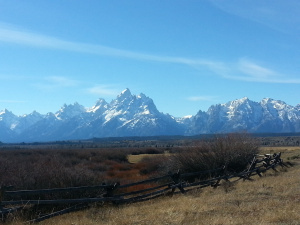 Nothing takes my breath away quite so much as the landscape of northwestern Wyoming. If I say it leaves me speechless, you will understand how very difficult it is for me to relate the love affair I have with this small section of our vast country, how I feel no dictionary is complete enough to supply words to describe this patch of land where the earth has struggled like an indecisive artist to create high plains that stretch themselves into the harsh, jagged peaks of the Tetons. One can only feel reverence, one can only feel a minute speck in the vast panorama; it makes you realize how tiny and inconsequential you are in the scheme of things. So now, imagine how envious I am of those who are lucky enough to live there year-round compared to my two, comparatively brief stays each year. Then you can realize both the awe in which I hold those who homesteaded this unforgiving country and the jealousy I feel that they were able to live here. This is a land that gives you a sense of history, a sense of destiny. It is a geography of hope, forged by nature and hard won by man.
Nothing takes my breath away quite so much as the landscape of northwestern Wyoming. If I say it leaves me speechless, you will understand how very difficult it is for me to relate the love affair I have with this small section of our vast country, how I feel no dictionary is complete enough to supply words to describe this patch of land where the earth has struggled like an indecisive artist to create high plains that stretch themselves into the harsh, jagged peaks of the Tetons. One can only feel reverence, one can only feel a minute speck in the vast panorama; it makes you realize how tiny and inconsequential you are in the scheme of things. So now, imagine how envious I am of those who are lucky enough to live there year-round compared to my two, comparatively brief stays each year. Then you can realize both the awe in which I hold those who homesteaded this unforgiving country and the jealousy I feel that they were able to live here. This is a land that gives you a sense of history, a sense of destiny. It is a geography of hope, forged by nature and hard won by man.
One of the men who would put his mark on this country was J. Pierce Cunningham. A fellow New Yorker, he arrived in the Jackson Hole area of the Tetons around 1885, aged about twenty. A few years later, he and his wife staked 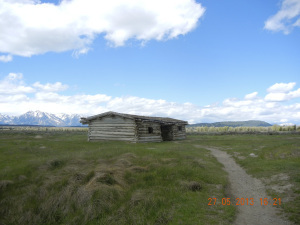 a claim under the Homestead Act, and thereby laid the foundations for what would become the Bar Flying U Ranch. The cabin they built, which under the Act had to be at least 12 x 12, was what is commonly known as a dogtrot or double-pen cabin, encompassing two separate rooms with a dogtrot or breezeway in-between. Although a more substantial home was eventually built, along with sheds, barns and other outbuildings, it is the original cabin that still stands today.
a claim under the Homestead Act, and thereby laid the foundations for what would become the Bar Flying U Ranch. The cabin they built, which under the Act had to be at least 12 x 12, was what is commonly known as a dogtrot or double-pen cabin, encompassing two separate rooms with a dogtrot or breezeway in-between. Although a more substantial home was eventually built, along with sheds, barns and other outbuildings, it is the original cabin that still stands today.
When I first visited Cunningham’s cabin I was immediately struck by the isolation of this remote location, how lonely it must have been in the 1880s. Although more than four hundred claims were filed in Jackson Hole in the latter part of the nineteenth century, the vastness of the valley meant there could be little interaction, especially during the harsh winter months. And this was a hardscrabble life; rocky soil led to high operating costs as ranchers struggled to feed their cattle during the long winter. The horrendous winter of 1886/87, as I described in my book Loveland, put an end to much of the open range ranching.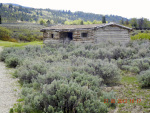
One might think, why do it then? I can only answer for myself as to what I feel when I stand there, surrounded by a landscape so startling, so inspiring, you feel purified, whole, inconsequential and ephemeral. Not having been born there, I cannot fathom my own attachment to this place, why I feel the oft-repeated need to return there, but it somehow cleanses me, clears my head. It was obvious that I somehow had to employ this site as the backdrop for a book. You might think it a poor reckoning, to use a setting so magnificent in my modest western historical romance. After all, I could not possibly do it justice.

The view from Cunningham’s cabin
But I have tried…
Dearest Darling comes out Oct. 8th from The Wild Rose Press. To celebrate, I’ll be giving out copies of both this new novella and my full-length novel, Loveland, to up to 5 people who leave a comment. Winners will be announced on or about 9th Oct.
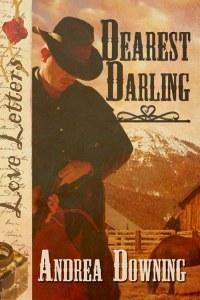 Stuck in a life of servitude to her penny-pinching brother, Emily Darling longs for a more exciting existence. When a packet with travel tickets, meant for one Ethel Darton, accidentally lands on her doormat, Emily sees a chance for escape. Having turned down the dreary suitors that have come her way, is it possible a new existence also offers a different kind of man?
Stuck in a life of servitude to her penny-pinching brother, Emily Darling longs for a more exciting existence. When a packet with travel tickets, meant for one Ethel Darton, accidentally lands on her doormat, Emily sees a chance for escape. Having turned down the dreary suitors that have come her way, is it possible a new existence also offers a different kind of man?
Daniel Saunders has carved out a life for himself in Wyoming—a life missing one thing: a wife. Having scrimped and saved to bring his mail-order bride from New York, he is outraged to find in her stead a runaway fraud. Even worse, the impostor is the sister of his old enemy.
But people are not always as they seem, and sometimes the heart knows more than the head.
EXCERPT:
Emily liked the sound of his voice, low but not husky, a slight twang he had cultivated, but not pretentiously so. When he spoke, she envisaged melting caramel, something delicious, the way it could be so appealing as she stirred, with a shine and slow drip from the spoon, before it gradually solidified. Soothing. A liquid velvet.
But he hadn’t spoken today. Not since first thing when he’d told her to get ready. Not through breakfast, or as he helped clear dishes, or gave her a hand up into the wagon.
“You haven’t seen her. You didn’t see her picture, did you?” The questions came sudden, yet without malice.
Emily straightened, alert. “No. No, I didn’t.” Would I understand better? Is that what he meant?
“I keep it with me.” Daniel began to fish in his pocket. “Would you like to see it?”
“No. No, you keep it, please. It won’t change anything.” Emily panicked. She would be beautiful, the other, that would be the answer. So stunningly beautiful that just her photograph had enthralled him, mesmerized him into loving her. Emily couldn’t bear to look, didn’t want to know the answer. Didn’t wish to torture herself further. “And I’m sorry. I’m sorry for reading the letters.” A rush of words, they flowed out of her. “I should never have done that. It’s not like me. But you…well, you understand it seems—”
“You’re probably wondering what I see in her. Or what she sees in me. As for that, what she sees in me, I have no idea. Maybe, like you, she wishes to get away.”
Emily studied his profile, the planes and contours of his face, the eyes set straight ahead, the slouch hat low on his brow. He gave nothing away, was a man in control of his emotions, thinking, maybe still wondering how he had won that woman. Or maybe set on keeping the answer to himself.
Overhead, clouds scudded, scoured the sky, leached the blue, threatened.
“Did you ever ask her? Why you?”
“I did. She never answered. I’m thinking what she sees in me is husband material. I guess. She tells me about her day, the people she knows, what she does. As you read.”
“She just seems so…so outgoing, so…so very social to ever want this life. I found it difficult to believe.” She jutted her chin out, then turned to him, waiting.
He gave the reins a sharp shake. “I don’t know. I never asked if she knew what she was getting into. I described it. I assumed if she wanted to stop the correspondence there, she would have. I was pretty damn amazed and happy she’d wanted to come, written back even though I described the cabin to her, the isolation.” His gaze slid toward her.
“And you think she’ll make you a perfect wife, do you? Be happy living here? Cook your meals, mend your clothes, keep your cabin, have your babies?” Exasperated, she tried to make him think, think of what he was letting himself in for, how long a marriage like that could go on, how it could end up being even lonelier than he was now. Emily would seem to him to be trying to win him over rather than making him see the truth, but push him she must, save him, stop him. She knew those sorts of women, the debutantes, the socialites. Not a one would last out here, not for a single day.
His head snapped around to stare at her. “She’s been writing. She hasn’t stopped.”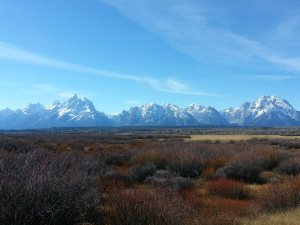
Buy at: Amazon: http://www.amazon.com/Dearest-Darling-Letters-Andrea-Downing-ebook/dp/B00NGWT816
The Wild Rose Press: http://www.wildrosepublishing.com/maincatalog_v151/index.php?main_page=product_info&cPath=195&products_id=5842


September 3, 2014
Riches to Rags: The Men Who Found Gold
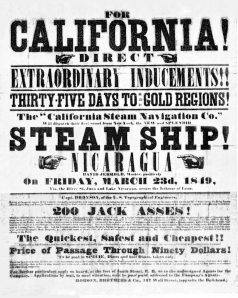
1849 poster ad for ship to California Gold Rush
Anyone who has ever studied history of the United States will associate the words, ‘Sutter’s Mill,’ in connection with the California Gold Rush of 1849. They may know John Sutter as owner of that mill, and they may even know that it was James W. Marshall, Sutter’s foreman at the mill, who made the actual discovery of gold. After that, most history books go off into the gold rush itself, and its effect on the expansion of the United States, and the development of California in particular. Sutter and Marshall, now as then, get pushed aside. And the truth of the matter is the men who went into the history books, who really made money out of the gold rush, were the merchants who supplied the 49ers—men like Leland Stanford, Mark Hopkins and Levi Strauss. Sutter and Marshall just got trampled on…
John Sutter, a German Swiss immigrant, had made money in trade and received a large land grant from the Mexican government, who had possession of California at the time. Making a deal with the disbanding Russian colony at Fort Ross, Sutter obtained various livestock and implements, and built his own fort called New Helvetia. With dreams of starting an agrarian community, he employed a decommissioned battalion of Mormons, who had come to California with the army of General Kearny.
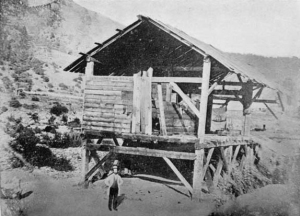
James W. Marshall at Sutter’s Mill, 1850, from a daguerrotype by R.H. Vance
He set them to work building a sawmill on the south fork of the American River under the management of his foreman, James W. Marshall, to whom he purportedly gave a half-interest in the mill.
On 24th January, 1848, Marshall discovered what he believed to be gold. Being a good partner and faithful employee, he showed the metal to Sutter, the men ran tests, and they ascertained that the metal was, indeed, gold. Shortly after, on 2 February, 1848, the United States and Mexico signed the Treaty of Guadalupe Hidalgo, thereby bringing the Mexican American War to an end, giving the U.S. half of all Mexican territories including, of course, California, and eventually ruining the two men’s lives.
Although Sutter obtained promises from his Mormon workforce to keep the gold a secret, it wasn’t long before they discovered they could make more money mining the gold than the wages Sutter was paying them. Naturally, rumors spread and, despite the spread being rather slow in those pre-telecommunication days, and the rumors somewhat enhanced with the telling, the California Gold Rush had begun.
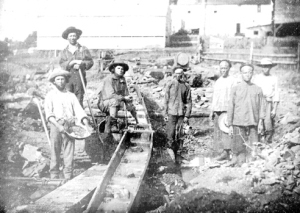
Anglo and Chinese miners circa 1852. Daguerrotype by J. B. Starkweather
Forty per cent of enlisted men in California deserted, two-thirds of homes in San Francisco stood empty and John Sutter’s land was invaded. And this is where the history books veer off into American expansionism, fortunes won and lost, wagon trains heading across the great plains, and possibly even the building of the Panama Canal—or at least the building of the Panama Railway, which preceded it. But what happened to Sutter and Marshall?
Sutter’s agrarian community was decimated by the influx of miners, who killed his livestock for food and stole everything in sight. When he appealed to the courts for restoration of his land, the title was declared invalid because it was a Mexican land grant. Three years later, in debt, Sutter retired to his Hock Farm and deeded the remains of his land grant to his son (who would subsequently initiate the building of Sacramento). He did eventually receive a stipend of $250 a month for the taxes he had paid, and moved to the Moravian community in Pennsylvania. He continued to petition the United States government for fifteen years; in fact, two days before his death, Congress adjourned without action on yet another bill that would have given him reparation.

James W. Marshall
As for Marshall, who actually discovered the gold, he, too, had his land claim overrun and his belongings stolen. He, too, sought restitution through the courts to no avail and ended up with just the clothes he stood up in. Joining the hordes looking for gold, crowds would surround him when he would try to find another lode because they believed he had powers of divination. This apparently went on for some seven years until he returned to the small town near his lost mill and earned money by doing odd jobs. Eventually, he was able to own land again and started growing grapes, but such a high tax was levied on the resulting wine that he went bankrupt. In 1871, Marshall started a lecture tour, which eventually took him to Salt Lake City. There, Brigham Young declared he was a liar because it was in the Church records that Mormons had discovered the gold… The California State legislature did, in time, give him a small pension, which they discontinued two years later due to his drinking. Marshall lived until 1885, existing by woodworking and carpentry.
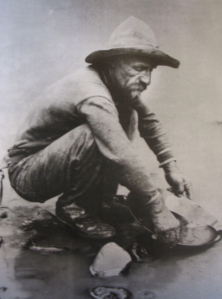
Panning for gold, California, 1850. Photo by L.C. McClure.
Of course, as the Present has a way of making cack-handed amends for the Past, the Society of California Pioneers and the Native Sons of the Golden West buried Marshall on a hill overlooking the original site of Sutter’s Mill. They spent a great deal of money for a monument to the man no one supported in life, and now pay a salary to a caretaker for this important site. And Sutter? Over the years, various streets, schools and other geographic places—as well as a rose—have been named after him. And California rebuilt his vandalized fort for the tourists—and maintain it, no doubt, at great cost.
Main source: Brown, Dee: The Westerners, London, 1974
All photos are public domain


August 3, 2014
Before They’re Gone–The Work of George Catlin
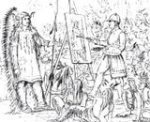 There are many artists known for their paintings of the West, but the one whose work enthralls me the most is George Catlin. Working somewhat in the ‘naive’ style, Catlin’s life work was to capture the American Indian before they vanished, and this he did: his subjects came from over fifty nations.
There are many artists known for their paintings of the West, but the one whose work enthralls me the most is George Catlin. Working somewhat in the ‘naive’ style, Catlin’s life work was to capture the American Indian before they vanished, and this he did: his subjects came from over fifty nations.
Born in 1796 in Wilkes-Barre, Pennsylvania, later moving to upstate New York, Catlin’s fascination with American Indians started at an early age. His mother had regaled him with her tales of being a captive of the Iroquois during the Revolutionary War, and his cheek bore a scar from a ‘tomahawk’ thrown in a childhood game.
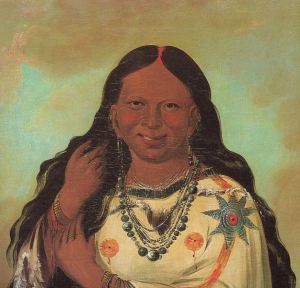
Ojibwa woman, ca. 1832
An encounter in 1805 with an Oneida may also have influenced him. Although he initially studied law, Catlin was accepted by the Philadelphia Academy of Fine Arts and started his career as a portraitist. Successful enough to be commissioned by clients such as Sam Houston and Dolly Madison, Catlin spent time in Philadelphia’s museums painting tribal costumes, weapons and ornaments brought back by Lewis and Clark. When a delegation of Native Americans came to Philadelphia in full regalia, his ambition took root.
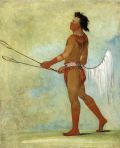
Choctaw Stickball player, ca. 1834
Catlin began by painting people from the various tribes in upstate New York. His empathy for the Indians is obvious in his work, portraying them as individuals rather than savages—the general concept of the day. Catlin foresaw that they would soon be wiped from the earth by diseases such as small pox, and ills such as whiskey. When the Indian Removal Act of 1830 forced tribes of the southeast on the notorious Trail of Tears, Catlin decided—despite being recently married—to venture west.
Armed with letters of introduction as well as some of his earlier work, Catlin called upon William Clark in St. Louis. Clark was then Governor of Missouri Territory as well as Indian Agent for the Territory of the Upper Louisiana, the latter position giving him full authority over all Indian matters in the West. Clark let Catlin set up his easel in his office where he painted visiting Native Americans there to trade or for treaty matters.
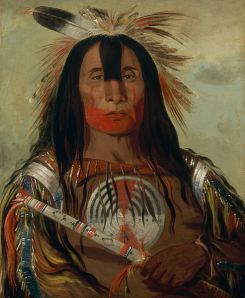
Buffalo Bull’s Back Fat, a Blood Chief, ca. 1832
Subsequently, he and Clark became close friends, and Clark took Catlin up the Mississippi to a council with Sauks and Foxes, and again up the Missouri and overland to Kansas. Clark also posed for a full length portrait.
During six years from 1830 to 1836 Catlin traveled throughout the west, returning to his family for the winter. He painted warriors and women at work, villages, buffalo hunts, ceremonies and the scenery of the west, as well as everyday implements the Indians used. So many purportedly wanted their likenesses drawn, it was often necessary for Catlin to develop a shorthand of sketching and filling in later. In addition to painting the Plains Indians, he made trips up the Arkansas and Red Rivers, and into Florida and the Great Lakes.

A Mandan Village, ca. 1833
Catlin was determined that the world should see the American Indian through his paintings and, to this end, he started a series of exhibitions and lectures, including not only the paintings but artifacts and costumes he had collected as well. ‘Catlin’s Indian Gallery,’ as it was called, was largely successful and motivated him to approach Congress with the idea the collection should be bought as the basis for a museum. Despite the support of Daniel Webster, Henry Clay and William Seward, the resolution got no further than the House of Representatives.
This apparent failure prompted him to take the collection to London. There he received such popular support he remained for five years, the exhibitions evolving over time into a sort of Wild West show. This eventually went on to Paris where he was befriended by King Louis Phillipe and the paintings were exhibited in the Louvre.

A Choctaw woman, ca. 1834
However, when revolutionaries overthrew the King, Catlin was forced to return to England. Bankrupt and surrounded by creditors, he was bailed out by one Joseph Harrison of Philadelphia, who took possession of all the works.
By 1852, with his wife deceased and his children sent back to America, Catlin was persuaded by a Parisian acquaintance to go to Brazil in search of gold. He found no gold but proceeded to paint the indigenous peoples of South America over the next five years. He later made trips to Alaska and up the Columbia and Snake Rivers, crossing the Rockies and canoeing down the Rio Grande.
In 1870, Catlin returned to the United States. He had a collection of copies of his original works, which he now called a Cartoon Collection, as well as an historical
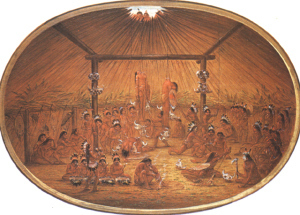
Okipa, a Mandan ceremony, ca. 1835
series he had done for Louis Phillipe. With the Indian Wars now raging in the west, Catlin received an invitation from the Smithsonian Institution to exhibit . Catlin saw this as his last chance to persuade the government to take possession of this pictorial record of a peoples and life that would soon vanish. But in 1872 Congress was more concerned with defeating the Indians rather than gaining pictures of them, and George Catlin passed away in October of that year, his life’s work packed away .
In 1879, the heirs of Joseph Harrison donated the original Catlin gallery to the government. Moth-eaten and with smoke and water damage, the Smithsonian restored them, finally putting them on show for seven years from 1883. In 1912, one of Catlin’s surviving daughters sold the cartoon collection to the American Museum of Natural History while others were in the collection of Paul Mellon, who donated them to the National Gallery of Art.
While Catlin’s work may not be regarded as great as a Remington or Russell, for me, the palette, the vitality of the paintings and the sincerity of the portraits is more enthralling than either artist.
George Catlin rests in a Brooklyn cemetery.

Boy Chief, Ojibbeway, ca. 1843
All photographs of paintings are public domain.


July 1, 2014
BE IT EVER SO HUMBLE: LIFE IN EAST HAMPTON, THEN AND NOW
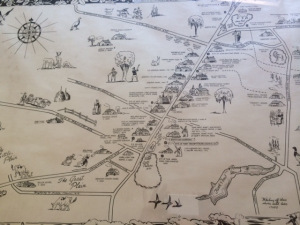
Map in my possession showing the village on its 300th anniversary, 1948
It’s a source of some amusement to me that John Howard Payne, lyricist of the immortal ‘Home Sweet Home’ (“Be it ever so humble, there’s no place like home…”) spent his youth in East Hampton. In fact, the small colonial residence of his grandfather, where he lived, is now a museum, sitting on Main St. amongst a line of colonial and Victorian properties. But East Hampton is hardly known for its history. Programs such as ‘Royal Pains’ and ‘Revenge’ as well as a plethora of films, including ‘Something’s Gotta Give,’ continue to perpetuate the image of ‘The Hamptons’ as the enclave of the rich and famous. That’s hardly true of the entire population! And it certainly wasn’t always true…
As with all of the Americas, indigenous peoples were present long before European settlers made an appearance. The locals then were a part of the Algonquin nation, generally called Montauketts. In the late 17th Century, Puritan and other colonists from Connecticut moved down to the Long Island area. A smaller island off shore was sold to one Lion Gardiner for a large black dog, some powder with shot, and a few Dutch blankets. Today the taxes alone on the island are purported to be over 2 million dollars…and the island continues to be owned by descendants of the Gardiner family. In any event, Gardiner’s Island was the first English settlement in what became New York.
Gardiner built a second home, in what is now East Hampton, in 1654.

Mulford Farm, now on The National Register of Historic Places
Earlier, in 1640, Puritan families had moved down from Massachusetts to the Southampton area, escaping strict laws and seeking more land, and had migrated east to what they then called Maidstone in 1649. They signed a treaty with both the Montaukett and Shinnecock peoples, buying the land for 20 coats, 24 looking glasses, 24 hatchetts, 24 knives, 24 hoes and 100 “muxes.” They then secured a patent or colonial charter from Governor Richard Nicholls in 1666. The village of East Hampton subsequently developed from 34 allottments of 8 to 10 acres since life here in the colonial period was based on farming. Note that the town and the village are 2 distinct entities; today, East Hampton Town includes the villages of Wainscott, part of Sag Harbor, East Hampton, Napeague, Amagansett and Springs.
The main government during the colonial period was the town council. The town records give some idea of the concerns of the people:
“November 27 agreed that the Indians shall cut no wood nor timber nor live in…field.”
“1756 October 27 The Trustees did then chuse, nominate and appoint John Dayton by mager vot for to sue, prosecute and recover the damage the Town shall or may receive from any person that shall at aney time presume to hunt after Deere or fowl in the Town ship of Easthampton the person not being…an inhabitant of said town.” (sic)
“Novem 9th agreed with ye Indians for to tak up with Seven pounds for the damage their hogs had don in rooting up ye land…” (sic)
There is also a list of charges to the Town, such as “1733 to Ichabod Leek for warning ye trustees 1’6” –though no mention is made of what he was warning them about!

1770 House, now a restaurant
During the Revolution, the village was occupied by the British from 1776 to 1783. Various myths and stories come out of this period but my favorite is that in 1776 a “certain Stirring Dame” of East Hampton threw a hot pudding filled with berries at a foraging party of British soldiers. The site of this incident is still known as “Pudding Hill.” My own street, Whooping Hollow Rd., also has an interesting legend: originally called, “Whooping Boy’s Hollow,” it tells of an Indian boy who was scalped on the road by hostile Indians. His whooping spirit still supposedly haunts the area.
Over the years, the region developed as a farming, fishing and whaling community. Working class families moved into Springs (never use “the”!) and were called by the name of Bonnackers, referring to the fact that Springs is on Accabonac Harbor. They have their own dialect, now mostly softened by the New York infiltration, which developed from 17th C England. Sadly, the local fishing industry, which was their main occupation, has dwindled, and many now work in various fields related to tourism, while Springs also supports a large Latino community.
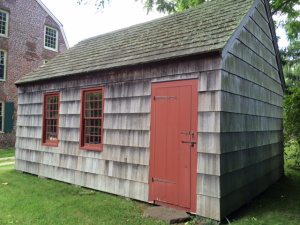
Original colonial house
So when did the rich and famous move in? In the late 19th century Southampton proved a draw for the wealthy of the Gilded Age and is still known as the Hampton of ‘old money.’ It’s streets have signs protesting against wearing bathing suits in town, and an elegance of a by-gone era still exists in the old mansions that line the shore. East Hampton remained largely rural until the railroad came in 1880. When the Maidstone Club was built in 1891, the wealthy came along; to this day, membership is extremely difficult to obtain. East Hampton drew a more artsy crowd in the 1950s when artists such as Jackson Pollock, whose house is open to the public, and buddies like Warhol, Motherwell, Kline and so on came out to work in the peace and quiet of the countryside. And so, East Hampton developed as the Hampton of the celebrities, with the Artists and Writers’ baseball game a highlight of the summer season. I’ve gone through a door with Catherine Zeta Jones while Michael Douglas looked on, been in restaurants while Salman Rushdie, Martha Stewart, Gabriel Byrne or Renee Zellwegger dined nearby, shopped when Alec Baldwin has popped in, attended a benefit basketball game with Jay-Z, and stood outside the movie house with Steven Spielberg, with whom I’ve also exchanged a few words while canoeing out on Georgica Pond. Charity events go on throughout the summer as do art and antique shows, theatre, church fairs and readings by well known authors. Polo is played and The Hampton Classic Horse Show is a major event. And these days, the Town Council deals with a mixed population in a growing community, while trying to maintain the rural atmosphere of a town with very limited land, caught as it is between Long Island Sound and the Atlantic Ocean. The Ladies Village Improvement Society (known as LVIS) keeps a stern eye on any change not consistent with the historic setting.
As quite an ordinary person I feel lucky to live here.

East Hampton Library
The library is unlike most libraries, having been built rather like a Tudor home complete with grand staircase and sitting area by a fire. The two windmills and other historic buildings are beautifully kept, as is the old cemetery near the village pond. It’s a beautiful village in which to live. Yet when I bought my home, 16 years ago,  the village had lovely little ‘Mom and Pop’ stores and was relatively uncrowded after Labor Day. Nowadays the village is given over to stores the likes of Gucci, Tiffany, Ralph Lauren and Hermes, as if someone might have a handbag emergency—and they mostly close down for the winter months. The beaches are public but parking there is not; residents have to obtain permits with identity to show they live here, and there is a strict division between town beaches and village beaches, depending on where you live. Restaurants go in and out of fashion and in and out of business in the twinkling of an eye. The general aura is that the summer visitors matter the most.
the village had lovely little ‘Mom and Pop’ stores and was relatively uncrowded after Labor Day. Nowadays the village is given over to stores the likes of Gucci, Tiffany, Ralph Lauren and Hermes, as if someone might have a handbag emergency—and they mostly close down for the winter months. The beaches are public but parking there is not; residents have to obtain permits with identity to show they live here, and there is a strict division between town beaches and village beaches, depending on where you live. Restaurants go in and out of fashion and in and out of business in the twinkling of an eye. The general aura is that the summer visitors matter the most.
In my forthcoming book, Dances of the Heart, East Hampton is portrayed in the way most people think of it, a glitzy summer resort, home of the wealthy. But that said, my own preference is to be here in the late autumn or early spring when the weather is good but the crowds are gone—and the only thing to contend with are those descendants of the ‘Deere and fowl’—mainly wild turkeys—that the settlers didn’t want shot.
(One final note to my western readers: John Howard Payne eventually lived with the Cherokee, coming to a theory that they were the lost tribe of Israel…)


May 31, 2014
A Question of Bounty
Back in October 2012, Paul Colt visited this blog with a post about Pat Garrett and Billy the Kid. Paul’s latest book, A Question of Bounty: The Shadow of Doubt is published this month by Five Star. Here he takes a second look at the death of Billy the Kid.
**********************************************************************
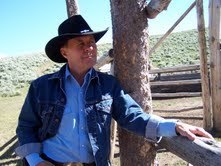
Paul Colt
Two years ago Andi gave me the opportunity to share one of my favorite historical controversies. Pat Garrett claims he killed Billy the Kid, July 14, 1881. John Poe, Garrett’s deputy on the scene that night—and others—question Garrett’s claim. They suggest he killed the wrong man and covered it up.
Today, Garrett’s claim rests on his 1882 book, The Authentic Life of Billy the Kid. The printed word has never been more powerful than it was in the nineteenth century yet it was not always dependable.. Libbie Custer’s idyllic portrayals of her husband George and the legendary treatment given numerous nineteenth century figures all testify to the difference between fact and the cachet of fact.
Garrett’s book remains the accepted historical record of the Kid’s death. What is surprising is that the controversy surrounding his claim also continues to this very day. Why? Because there are contradictions, irregularities, and circumstantial evidence that simply won’t go away. We are left with the question: is Garrett’s claim proven beyond the shadow of doubt, or is it a hastily conceived cover-up?
The controversy piqued my curiosity when I picked up John Poe’s memoir, The Death of Billy the Kid, and laid it beside Garrett’s book. Poe, a respected law enforcement officer and political figure of his time, enjoys a somewhat better reputation than the often financially troubled Garrett. If you take Poe for a credible witness to the events of the Kid’s death, you are left with two differing accounts, procedural irregularities, circumstantial evidence and unanswered questions.
According to both Poe and Garrett, they, along with deputy Kip McKinney, set up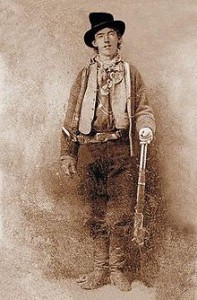 a watch for the Kid in an orchard on the edge of Fort Sumner on the night of July 14th. Garrett states that someone resembling the Kid approached Pete Maxwell’s house and he followed him. Poe claims that Garrett entered the Maxwell house to question Maxwell before anyone arrived. By Poe’s account, Garrett left his deputies on watch outside where they were seen by the man who next entered the house. This is significant.
a watch for the Kid in an orchard on the edge of Fort Sumner on the night of July 14th. Garrett states that someone resembling the Kid approached Pete Maxwell’s house and he followed him. Poe claims that Garrett entered the Maxwell house to question Maxwell before anyone arrived. By Poe’s account, Garrett left his deputies on watch outside where they were seen by the man who next entered the house. This is significant.
Imagine you are the Kid, a desperado with a death sentence hanging over your head. Late at night you encounter strangers skulking about your intended destination. Do you go inside to find out who the unknown visitors are; or do you scoot back to your hidey-hole? If you are one of the Kid’s friends in the area, you have no reason to fear the unidentified strangers but your instinct is to warn your friend. You might go inside to find out the stranger’s identity.
As Garrett tells it, the Kid entered Pete Maxwell’s darkened bedroom and asked Maxwell in Spanish the identity of the men outside. Poe’s account agrees with this. But why would the Kid inquire in Spanish? Maxwell spoke English. The Kid spoke Spanish but it wasn’t his first language. On the other hand, the Kid had a goodly number of—obviously Spanish-speaking—Mexican friends in the area. Garrett claims he recognized the Kid’s voice in the dark and shot him. Was it the Kid, or one of his friends?
If the Kid was hiding in the area when the shooting occurred, he could easily have decided that a report of his ‘death’ was better than the pardon he’d sought. Could he have escaped that night and assumed some new identity? It seems a reasonable speculation.
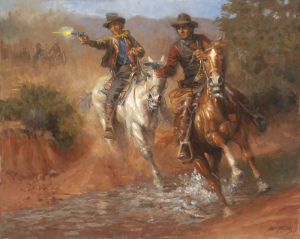 Garrett and Maxwell took charge of the body and the events that followed. Their actions are tainted by serious irregularities. Maxwell is reported to have written the coroner’s report and the verdict for a coroner’s inquest. The local postmaster signed the inquest verdict as foreman the following morning. The jurors never met as a group. The Justice of the Peace, who allegedly impaneled the jury, made no official record of it. The coroner’s report and inquest verdict were entrusted to Garrett to file at the Lincoln County Courthouse. Neither document has ever been found. Is it possible Garrett ‘lost’ documents he feared wouldn’t stand up to close scrutiny? A facsimile of what appears to be the inquest verdict was discovered decades later. Misspellings and the use of ‘marks’ witnessed by Pete Maxwell suggest that some of the jurors’ signatures may have been falsified. Then there is the facsimile. The technology wasn’t invented until decades later. If a photocopy was made of the original, what happened to that document? Could the original have been a forgery disguised by facsimile to prove the Garrett claim?
Garrett and Maxwell took charge of the body and the events that followed. Their actions are tainted by serious irregularities. Maxwell is reported to have written the coroner’s report and the verdict for a coroner’s inquest. The local postmaster signed the inquest verdict as foreman the following morning. The jurors never met as a group. The Justice of the Peace, who allegedly impaneled the jury, made no official record of it. The coroner’s report and inquest verdict were entrusted to Garrett to file at the Lincoln County Courthouse. Neither document has ever been found. Is it possible Garrett ‘lost’ documents he feared wouldn’t stand up to close scrutiny? A facsimile of what appears to be the inquest verdict was discovered decades later. Misspellings and the use of ‘marks’ witnessed by Pete Maxwell suggest that some of the jurors’ signatures may have been falsified. Then there is the facsimile. The technology wasn’t invented until decades later. If a photocopy was made of the original, what happened to that document? Could the original have been a forgery disguised by facsimile to prove the Garrett claim?
The body was buried the following morning. It was not publicly displayed as was the custom with high profile outlaws. No photos were taken of the body or Garrett with the body as was also the custom. All this favors the appearance of a cover up.
If Garrett killed the wrong man, he obviously had motive enough for a cover up. That begs the question why would Pete Maxwell help him? History tells us that the Kid was romantically involved with Pete’s younger sister, Paulita. Maxwell’s motive for participating in a cover-up might have been to get the Kid out of Paulita’s life once and for all.
There are those who vigorously defend Garrett’s account of the Kid’s death. The publication itself seems self-serving. The printed word firmly established Garrett’s claim to have killed the Kid. In the book, he suggests Poe and McKinney questioned the identity of the victim at the time of the shooting. He then goes on to refute the allegation. According to Poe, he initially supported Garrett; his doubts came later. Garrett’s book seems a convenient response to those suspicions.
Did Pat Garrett kill Billy the Kid? Historians are convinced. They have Pat Garrett’s word on it. The state of New Mexico is convinced. They’ve got an iconic legend and the tourist attractions that go with it. One hundred thirty years later questions remain. And leads to the ultimate question: if Garrett didn’t kill the Kid, what happened to him? Did he simply ride off ?
Two years ago I said I’d written a book based on Poe’s memoir. The story I call A Question of Bounty: The Shadow of Doubt speculates about what might have happened to the Kid if he did indeed walk away that night. The story focuses on a mysterious character, resembling the Kid, who appears out of nowhere mere weeks after the Kid’s alleged death. He lives a quiet life, never claiming to be the Kid and dies of natural causes years later. Admittedly his story is based on circumstantial evidence and hearsay. When I finished, I concluded that the controversy is one man’s word against that of another. Both cases are circumstantial. Neither case can be proven beyond the shadow of doubt.
Five Star Publishing will release A Question of Bounty: The Shadow of Doubt this 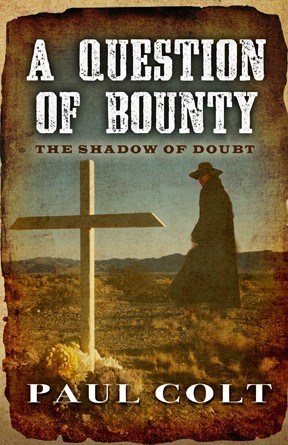 month. If you’re curious about what makes a controversy last one hundred and thirty years, I think you’ll find this one entertaining. In the end, you decide.
month. If you’re curious about what makes a controversy last one hundred and thirty years, I think you’ll find this one entertaining. In the end, you decide.
Enjoy the ride.
Paul Colt
***************************
Paul has very kindly agreed to give away a signed paper copy of A Question of Bounty to one person leaving an interesting comment. The winner will be announced here on or about the 23rd June.
‘Award winning author Paul Colt follows Billy the Kid’s outlaw adventures and unlikely young love affair to that fateful encounter with Sheriff Pat Garrett in Pete Maxwell’s bedroom. Colt gives the reader insight into the Kid’s life with richly visual settings and believable characters.’




